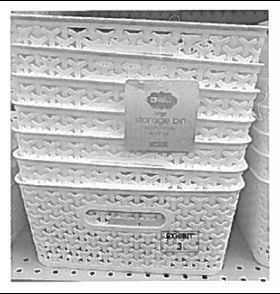The Court of Appeals for the Federal Circuit was tasked with determining whether a design patent with a claim for a "pattern for a chair" and drawings showing a pattern but no chair could be infringed by baskets which have the same pattern. In Curver Luxembourg, SARL v. Home Expressions Inc. (938 F.3d 1334, 2019), a case of first impression, the Federal Circuit provided guidance regarding the scope of a design patent.
 |
 |
|
Curver's Claimed Design (USD677,946) |
Home Expression's Baskets |
Finding for the defendant, Home Expressions, the Federal Circuit
determined that "claim language can limit the scope of a
design patent where the claim language supplies the only instance
of an article of manufacture that appears nowhere in the
figures." (938 F.3d at 1340). Traditionally, only
the figures of a design patent have been considered when
determining the scope of the claim; however,
in Curver, the Federal Circuit found that the scope
of protection is determined by considering what is shown
and described in the
patent. Accordingly, despite finding that Home
Expression's baskets incorporated the pictured
design, the Federal Circuit nonetheless held that
the baskets could not be found to infringe
Curver's patent, which claims a pattern for
a chair. In reaching this decision, the
Federal Circuit noted that the title of Curver's patent had
been amended during prosecution to a "pattern for a
chair" to satisfy the article of manufacture
requirement. The original title, "Furniture (Part
of -)", was rejected. The figure descriptions and
claim also were amended to be consistent with the title, leaving
Curver's patent replete with the phrase "pattern for
a chair." The Federal Circuit also
highlighted that none of the figures in Curver's patent showed
anything other than pattern itself; the pattern was not illustrated
on any particular article of manufacture.
Given the longstanding precedent that "design patents are granted only for a design applied to an article of manufacture ...," (938 F.3d at 1340) and not to a design by itself, the Federal Circuit held that Curver's text could not be ignored because the text provided the only source of identification of the article of manufacture of the patent. Thus, the scope of Curver's patent was defined by both the figures and the description and was limited to a chair.
What does this mean for your design patent protection? In view of this decision, applicants should consider carefully how their claimed design is shown and described in their design patent applications. The text of a design patent can matter and control the scope and meaning of your claim. The Court relied on the text in the description in this case because they found that the drawings did not include an article of manufacture. It remains to be seen whether the text of a design patent can limit the claim when an article of manufacture is shown in the drawings.
The content of this article is intended to provide a general guide to the subject matter. Specialist advice should be sought about your specific circumstances.



